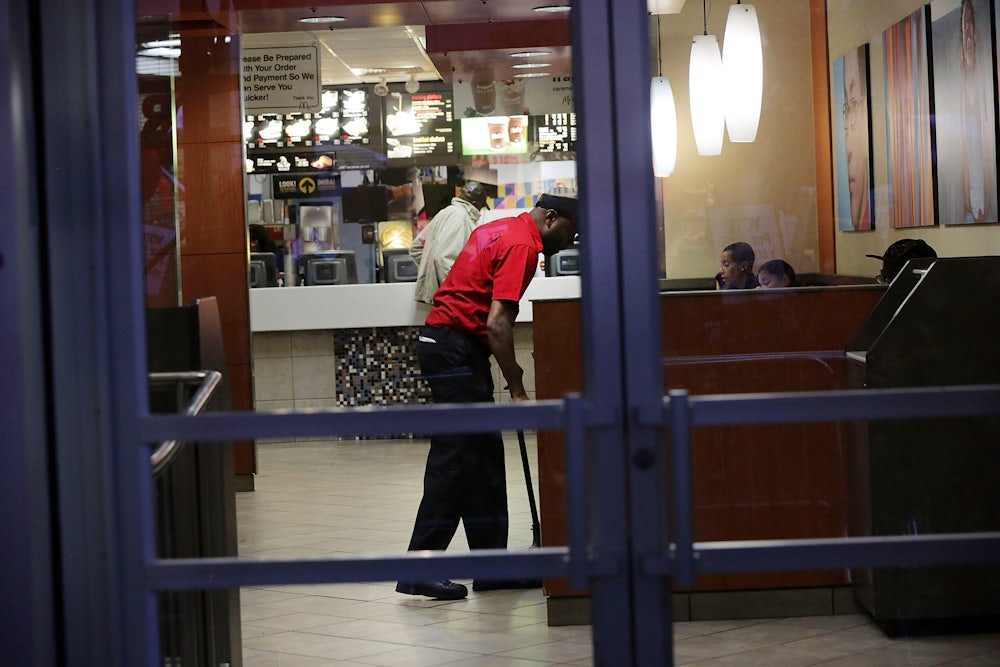A small segment of the population, Bloomberg reported earlier this week, possesses a type of partial immunity to the coronavirus: They’re rich. With the news that the virus has spread to 60 countries and counting, economic elites have begun making arrangements for concierge medical care, VIP access to early vaccines, and private jets to Idaho to hibernate off the grid until the threat of infection dissipates. “It’s been a full-on war-room situation over here,” said one doctor at a high-end private medical service that charges annual fees ranging from $40,000 to $80,000.
Meanwhile, the illness, which has so far affected an estimated 90,000 people and claimed the lives of more than 3,100 worldwide, shows no sign of stopping its spread in the United States. And as The New York Times noted, the very nature of inequality in America means that the virus is likely to spread fastest among service-sector employees and other low-income groups, particularly those who lack access to paid sick leave or health insurance. Likewise, the Economic Policy Institute pointed out last week that the virus-prevention guidelines released by the Centers for Disease Control and Prevention—which include staying home from work and promptly seeing a doctor if one suspects illness—aren’t really feasible for millions of workers: “The CDC recommendations all seem well and good, but how does someone with no paid sick days or insurance cope?”
The public health crisis threatening the U.S., in other words, is perhaps as much the result of economic stratification and a nearly nonexistent social safety net as it is the result of the coronavirus itself. While a few cities, such as San Francisco and New York, mandate guaranteed sick leave, there’s still no federal law that requires employers to provide either short-term or long-term paid sick leave. As a result, nearly one in four workers in the U.S. today must make the choice between getting well or getting paid when they fall ill, and those workers are disproportionately employed in occupations that require significant contact with the public. (“Right now, it’s kind of a balancing act between putting ourselves at risk and being able to keep the lights on,” Alva Ramos, a Lyft driver, told The Washington Post.) Pair that with our deeply dysfunctional health care system, in which 27.5 million people lack health insurance, and you have an epidemic in the making.
The recent outbreak at a Seattle-area nursing home, which to date is responsible for five of the nine coronavirus deaths in the U.S., reveals another problem with the lack of public services and privatization of care. While many nursing homes provide high-quality care, in a 2018 survey conducted by the AARP, 76 percent of Americans over the age of 50 said they would prefer to age in their homes. However, fewer than half said that they anticipated being able to do that. One major barrier to seniors living at home, as Bernie Sanders argued last year, is the exorbitant cost of home-based care, as well as the absence of any form of federal paid family leave that would allow seniors’ family members to take time off to care for them. (Contrast this with Sweden, where as of 2013, an estimated seven out of 10 elderly people received care at home, thanks to generous public spending.)
So far, the Trump administration’s response to the growing coronavirus crisis has largely ignored the types of measures that could address these underlying factors and help stanch the spread of the virus: footing the bill for all coronavirus-related medical treatment, regardless of an individual’s insurance coverage; mandating temporary paid sick leave; and increasing short-term compensation benefits for workers.
Congress has been working to pass new emergency funding to combat the virus, while the Trump administration, after an initial round of half-denials, has pledged to pump more resources into testing. But a lab test that tells you whether your flulike symptoms are coronavirus or something else is small comfort when you can’t afford the $3,270 bill. Even a number of Republicans seem to understand this and are considering government funding for hospitals treating uninsured victims of the virus: As Florida Representative Ted Yoho told HuffPost, “You can look at it as socialized medicine, but in the face of an outbreak, a pandemic, what’s your options?”
The administration seems to understand it has a role in preventing catastrophe on some level, at least for investors. Last week, Trump called on the Federal Reserve to cut interest rates in order to stabilize a wildly oscillating stock market. On Tuesday, the Fed complied, making its first emergency rate cut since the start of the Great Recession. “We saw a risk to the outlook of the economy, and we chose to act,” Fed Chair Jerome Powell said at a press conference that day. But if the last recession was any indication, the benefits of any new economic stimulus will go directly to the pockets of those who already have the means to deflect illness with luxury medical treatment and remote getaways.
Not even that attempt to revive the market has satisfied the president. In a bizarre mirror of the way that proponents of Medicare for All point to the U.S. as a global outlier on universal health care, Trump tweeted: “The Federal Reserve is cutting but must further ease and, most importantly, come into line with other countries/competitors. We are not playing on a level field.” He’s at least partially right.
